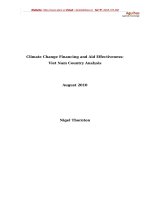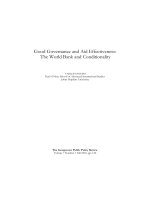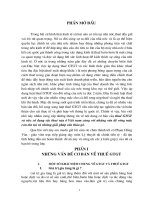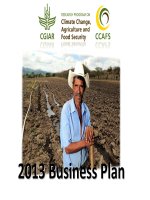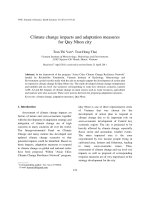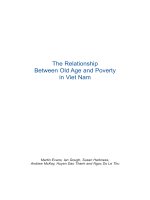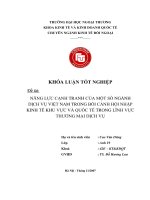Climate Change Financing and Aid Effectiveness: Viet Nam Country Analysis
Bạn đang xem bản rút gọn của tài liệu. Xem và tải ngay bản đầy đủ của tài liệu tại đây (237.57 KB, 32 trang )
Website: Email : Tel (: 0918.775.368
Climate Change Financing and Aid Effectiveness:
Viet Nam Country Analysis
August 2010
Nigel Thornton
Agulhas
Applied Knowledge
Table of Contents
Table of Contents...................................................................................................................2
Acronyms................................................................................................................................................5
Executive Summary...........................................................................................................................6
1.Introduction......................................................................................................................................9
2.Country context ..............................................................................................................................9
Following on from the earlier Partnership Group on Aid Effectiveness
(PGAE), the Aid Effectiveness Forum (AEF) was officially established in
February 2010 to provide the overarching architecture for government-
donor co-ordination around aid (and now development) effectiveness
issues. The AEF is an umbrella body for twenty Partnership Groups (PGs),
setting the overarching context for the relationship of the Government of
Viet Nam to external funding partners. The individual PGs deal with
specific sectoral or thematic issues. ...........................................................................10
In addition, the AEF (consistent with the spirit of the Accra Agenda for
Action) brings Civil Society Organisations, the National Assembly and
International Non-Governmental Organisations in to the dialogue with
government. ........................................................................................................................10
In interview, officials from the MOF said they were recommending that
MONRE build on its role as set out in the NTP and develop a set of clear
criteria for priority projects, which other line ministries should use to plan
accordingly. Line ministries and provinces should, it suggested, design
their projects based on these priorities, and then submit projects to
MONRE, MOF and MPI for approval (the latter being defined in this role as
set out in decree 131). This is a step change since the current NTP process
identifies that MONRE only set broad guidelines for ministries to set their
own priorities and design their own activities. .....................................................14
The issue is not just one of capacity, however. The roles of the main bodies
with an interest in climate change financing (MONRE, MARD, MPI, the
Ministry of Finance and the provinces) have still to be fully resolved in
practice. Respondents in MPI and MoF expressed a concern that while it
was perfectly acceptable that MARD and MONRE were in direct contact with
funders over support to their policy, there was a need for further
involvement of MPI and MoF in the discussions to ensure that financing was
fully integrated with national plans, budgets and processes. There is a
concern that if the secretariat for climate change remains in MONRE (or is
too closely identified with it), the climate change will remain an
environmental issue, rather than a developmental one. Similarly,
respondents in MARD noted MONRE’s status made their policy co-
ordination role difficult to carry out, and others outside government
2
Agulhas
Applied Knowledge
commented on MARD’s apparent unwillingness to co-ordinate effectively
with MONRE. However, respondents within MARD noted that they were in
regular communication with colleagues in MONRE and co-operation was
good. .......................................................................................................................................16
Other line ministries have also been recipients of significant external
funding that include climate change elements. For instance, the Ministry of
Infrastructure and Transport (MOIT) has received almost $600m from the
World Bank to fund improvements in energy production and the move to
renewable sources (see annex A), and provincial administrations also are
expected to be significant beneficiaries. Such funding highlights a
challenge for all partners when considering what is, and is not, classified as
climate change funding. Arguably, such funding and responses need to be
fully involved in the national response. ....................................................................16
Additionality ........................................................................................................................17
1. In Kyoto project-based mechanisms (i.e. Clean Development Mechanism
and Joint Implementation projects) additionality describes that a carbon
dioxide reduction project would not have occurred had it not been for
concern for the mitigation of climate change. It is thus beyond a “business
as usual” project. To qualify funding, a project has to demonstrate
additionality. ........................................................................................................................17
2. Additionality for climate change financing can also refer to donors
providing funds beyond “business as usual” ODA levels, in order to enable
communities and countries to adapt to climate change impacts. This means
identifying the additional cost to development programmes and projects
that adapting to climate change will require. It is also an area of
considerable international debate, since developing countries argue (as
they did at COP15 in Copenhagen) that this financing should not be classed
as ODA. ...................................................................................................................................17
Similarly, MOF prefers a modality of budget support over project financing
for climate change, or if not that programme based approaches. The Hanoi
Core Statement (and Paris Declaration’s) preference for non-projectised
modalities of assistance arguably works against the ready identification
and reporting of additionality, which is a key requirement of climate
financing mechanisms. To achieve this will require the more complex
marking of climate change spending within budgets, with considerable
definitional and technical challenges. .......................................................................17
4.Alignment........................................................................................................................................18
5.Harmonisation...............................................................................................................................21
6.Managing for results...................................................................................................................22
7.Mutual Accountability................................................................................................................23
8.Conclusions ....................................................................................................................................23
3
Agulhas
Applied Knowledge
The views expressed in this report are those of the author alone.
4
Agulhas
Applied Knowledge
Acronyms
AAA Accra Agenda for Action
ADB Asian Development Bank
AEF Aid Effectiveness Forum
CDM Clean Development Mechanism
COP Conferences of the Parties
D&D Deconcentration and Decentralisation
DSENRE Department of Science, Education, Natural Resources and Environment
GEF Global Environmental Fund
GoV Government of Viet Nam
HCS Hanoi Core Statement
HIV Human Immunodeficiency Virus
LMDG Like Minded Donor Group
MARD Ministry of Agriculture and Rural Development
MOF Ministry of Finance
MoIT Ministry of Infrastructure and Transport
MONRE Ministry of Natural Resources and the Environment
MPI Ministry of Planning and Investment’s
NGO Non-Governmental Organisation
NTP National Target Programme
NTP-RCC National Target Programme for the Response to Climate Change
OCCA Steering Committee for Climate Change Adaptation and Mitigation
ODA Overseas Development Assistance
PD Paris Declaration
PG Partnership Group
PGAE Partnership Group on Aid Effectiveness
REDD Reducing Emissions from Deforestation and Forest Degradation in
Developing Countries
SD&CC Sustainable Development and Climate Planning
SEDP Socio-Economic Development Plan
UN United Nations
UNDP United Nations Development Programme
UNFCCC United Nations Framework Convention on Climate Change
VN Viet Nam
WB World Bank
5
Agulhas
Applied Knowledge
Executive Summary
Background
This report is one of five country studies that have been commissioned by the Capacity
Development for Development Effectiveness (CDDE) Facility
1
supported by the Asian
Development Bank, Government of Korea, Government of Japan, Swedish SIDA and
UNDP as part of a regional dialogue process also supported by the OECD DAC. The
purpose of the initiative is to develop a set of recommendations regarding the
programming of climate change finance at the national level. The initiative seeks to
strengthen the management of climate change finance by beneficiaries and donors through a
consideration of Aid Effectiveness principles. Findings from the country studies will be
discussed in a workshop to be held in Bangkok, October 19-20 2010.
Interviews for this Viet Nam study were conducted with officials from key ministries and
with the external funders who were available over a three day period. This was thus a very
rapid exercise, and is not a comprehensive study. It can only begin to raise key issues and
is meant to be a prompt for discussion.
The UNDP UNFCC, UNDP, the World Bank and the Stern Review have all assessed that
Viet Nam is one of the countries particularly vulnerable to the adverse effects of climate
change, notably sea level rise
2
. Viet Nam is a signatory to the UNFCCC and the Kyoto
Protocol and has been an active participant in the Conferences of the Parties (COP). Viet
Nam has associated itself with the Copenhagen Accord. It is already benefiting from
considerable external funding for climate change from both global climate change funds
(such as GEF, CTF, UN-REDD), and bilateral sources (see Annex A).
Viet Nam is seen as a leader in aid effectiveness, having established mechanisms for donor
co-ordination in accordance with the Paris Declaration and Accra Agenda for Action
principles as localised in the Hanoi Core Statement. The Aid Effectiveness Forum (AEF)
was officially established in February 2010 to provide the overarching architecture for
government-donor co-ordination for ODA.
The Role of the Government
There is a growing understanding of the potential impacts of climate change on Viet Nam
among the country’s leadership. Climate change does not feature in the current Five Year
Socio-Economic Development Plan (SEDP). However, it is expected that it will be
incorporated into the next plan (2011-15).
The National Target Programme to Respond to Climate Change (NTP-RCC) has been
designed to strengthen and consolidate capacity building and research as well to initiate
action with sector ministries and provinces. It is not a national plan with costed
implementation projects, rather the NTP-RCC will lead to the identification of activities
and funding requirements. Ministries and provinces have been asked to develop costed
action plans for the response, but this process is not yet complete. In addition, other
1
More information on the CDDE Facility can be found at www.aideffectiveness.org
2
See Dasgupta, Susmita et al. (2007): The Impact of Sea Level Rise on Developing Countries. A Comparative Analysis. World Bank Policy Research
Working Paper 4136, February 2007, the UNFCCC 2007 “CLIMATE CHANGE: IMPACTS, VULNERABILITIES AND
ADAPTATION IN DEVELOPING COUNTRIES”, Stern, Nicholas et al (2006): The Economics of Climate Change: The Stern Review.
Cambridge,
6
Agulhas
Applied Knowledge
policies and programmes exist with an immediate bearing on climate change action that are
however not obviously addressed under the NTP-RCC and the forthcoming action plans.
These include policies on natural disaster risk management, energy efficiency, renewable
energy, and forestry, most of which have national-international coordination and dialogue
forums. An overarching strategy on climate change to address this and to ensure
prioritisation of action does not yet exist but is expected to be developed.
Most of the climate change funding provided to Viet Nam to date does not appear on the
government’s budgets, nor can it yet be fully captured using government systems. Any
reporting on financing for climate change, or its use, takes place through secondary
mechanisms.
The Ministry of Natural Resources and the Environment (MONRE) is the focal point for
climate change under the UNFCCC. While the Ministry for Planning and Investment
officially co-ordinates external financing and overall development planning and MOF is
responsible for budgeting, MONRE is tasked with the co-ordination of the national
response to climate change. However, it does not possess the mandate to coordinate other
ministries, and itself will not be the beneficiary of the largest sums of climate change
assistance that are likely to be given to ministries such as the Ministry of Agriculture and
Rural Development (MARD) the Ministry of Industry and Trade (MOIT), the Ministry of
Construction (MOC) and the Ministry of Transport (MOT), and provinces. This has
resulted in a lack of institutional clarity that the GoV still needs to address.
The Role of Donors
Although it has been the subject of some discussion in the AEF, there is no single forum
for the co-ordination of donor funding for the national response to climate change. Given
the lack of a single strategy, donors are also not yet aligning behind government plans.
Neither are they implementing their plans in a fully harmonised way. As a result they are
not working in a way that is consistent with the Hanoi Core Statement.
External funders are using grants and loans, project and budget support modalities to
support climate change activities. These funds come both from bilateral programmes and
from global funding sources, including the GEF. Respondents from the Ministry of
Finance noted they would prefer all assistance for climate change to be fully integrated into
national plans and provided in the form of budget support. It is recognised at present this
is not achievable, but should be the objective, according to them. However, whilst there
are some notable exceptions (such as JICA and AFD assistance for the NTP), the majority
of funding remains in a project-based modality.
Indeed there is not yet a formal commitment from external funding partners to align with
government activities for climate change or harmonise their activities beyond the umbrella
of the Hanoi Core Statement. There is no memorandum of understanding or Heads of
Mission agreement that deals explicity with climate change. Donors do expect to include
some elements of climate change financing within the next ODA framework that will
coincide with Viet Nam’s next five year plan. There is thus intended to be a higher level of
formal coherence with national budgeting processes than at present.
The Nature of Climate Change Financing
Viet Nam demonstrates the problem of defining what climate change financing is. Some
traditional ODA channels and activities, in part or in whole, deal with adaptation to or
mitigation of climate change (for instance funding for renewable energy or disaster risk
7
Agulhas
Applied Knowledge
management). For this ODA funding, provided as grants or loans by multilateral or
bilateral partners, it is possible to debate whether elements of this funding are additional to
‘business as usual’ ODA. Fundamentally, however, such funding would have to have
been provided, in spite of climate change.
Alternatively some funds use specific channels, and to be accessed have to be identified as
funding new and additional activities that will be necessary in order to adapt to or mitigate
climate change impacts. These funds are only required because of the detrimental effects
on development that will result from climate change. Such funding is seen not as
traditional ODA, but additional ‘climate finance’. Furthermore, climate finance has
introduced new modalities for funds transfers, with a range of different channels, including
the opportunity for trading of carbon credits between institutions and countries. It thus is
arguable whether its operation should adhere to Aid Effectiveness principles at all.
However, whilst Vietnam is able to directly access such funding, it does so through
traditional funding partners who manage such funding, and the funds in operation share
many of the same characteristics as ODA.
Conclusions
Viet Nam will require billions of dollars of external funding if it is to fully respond to the
challenge of climate change. The country is beginning to benefit from such funding, for a
wide range of adaptation and mitigation activities. Viet Nam does have the foundations in
place for a coherent response to climate change in accordance with aid effectiveness
principles. However, clarity on what should be included when discussing climate change
financing and the division of roles and responsibility within both GoV and among donors
needs to resolved, if the full response is to be developed. In particular, should all elements
of climate finance be provided in accordance with Aid Effectiveness principles, even
though it additional to ‘business as usual’ ODA? It is expected that the implementation of
the next five-year SEDP will overcome some of this uncertainty, and lead to increased role
clarity between line ministries. Donors will need to improve their co-ordination, and in
particular move to implement more fully their prior commitments to the Hanoi Core
Statement. Unfortunately, some of the difficulties result from the requirements of the
international architecture, and the definitions and operation of funding mechanisms, that
are outside Viet Nam’s control.
8
Agulhas
Applied Knowledge
1. Introduction
This report is one of several that have been commissioned by the Capacity Development
for Development Effectiveness (CDDE) Facility
3
supported by the Asian Development
Bank, Government of Korea, Government of Japan, Swedish SIDA and UNDP as part of
a regional dialogue process also supported by the OECD DAC. The purpose of the
initiative is to develop a set of recommendations regarding the programming of climate
change finance at the national level. The initiative seeks to strengthen the management of
climate change finance by beneficiaries and donors through a consideration of Aid Effectiveness
principles. Findings from the country studies will be discussed in a workshop to be held in
Bangkok in October 2010, with a view to influencing the country and regional response.
The analysis seeks to prompt discussion and debate on the nature of financing for climate
change, particularly in relationship to the principles for Aid Effectiveness articulated in the Paris
Declaration (PD) and the Accra Agenda for Action (AAA). The findings will be synthesized with
findings from similar studies in Bangladesh, Cambodia, Indonesia, the Philippines and Viet Nam.
It will be used as an input into a regional workshop to be held from October 19-20 2010 in
Bangkok.
This report considers current external climate change financing mechanisms, specifically
identifying whether and how aid effectiveness principles are being applied.
The process for the analysis included interviews with a limited range of stakeholders
(donors and government) as well as consideration of other written material in country.
Whilst led by an international consultant, it benefited significantly from contributions from
the UNDP funded project based in the Government of Viet Nam’s Ministry of Planning and
Investment’s Department of Science, Education, Natural Resources and Environment
(MPI/DSENRE), the Sustainable Development and Climate Planning (SD&CC) project,
Mr. Johan Kieft and Mr Le Duc Chung. Any findings are the author’s alone.
2. Country context
In the early 1990s, Vietnam was among the poorest countries in the world. Two decades
later, it has achieved Middle Income Country (MIC) status,
4
along the way lifting nearly
half of the population above the national poverty line.
5
Vietnam began its transformation from a command to a market economy in 1986, when
the 6
th
Party Congress launched the Doi Moi or ‘Renovation’ reform programme. Though
its impact has been dramatic, the transformation was a carefully managed process.
Economic transformation was accompanied by rebuilding ties with the international
community. In 1993, Vietnam resumed relations with the international financial
institutions (World Bank, IMF and ADB) and bilateral donors, giving it access to large-
3
More information on the CDDE Facility can be found at www.aideffectiveness.org
4
I.e., per capita GNI of more than US$995, which Vietnam achieved in 2009. According to some definitions,
a country must reach this figure in 3 consecutive years to qualify as a MIC, which would put Vietnam on the
threshold.
5
MPI, “Midterm Review of the 2006- 2010 SEDP Performance”, 2008.
9
Agulhas
Applied Knowledge
scale development assistance. It became an ASEAN member in 1995 and signed a
Bilateral Trade Agreement with the United States in 2001. In 2006, it became a member of
the World Trade Organization, and embarked on an ambitious programme of economic
reforms aimed to increase the country’s global competitiveness. The Vietnamese economy
responded rapidly to these reforms, growing at an average of 7.5% between 1990 and
2008.
Over the last two years, growth rates have slowed as a result of the global financial crisis.
There have also been important changes in the nature of economic growth, linked to
Vietnam’s achievement of MIC status. As productivity has increased, higher value-added
exports such as electronic products have become more important. There has been a major
real-estate boom (prices jumped 263% in 2007), with FDI shifting from industry into
hotels and other real estate.
The shift towards MIC status has also affected the nature of the aid dialogue in Viet Nam.
Traditional aid partners (particularly bilaterals) are beginning to leave or reduce their
programmes, and Viet Nam’s relationship with regional partners is becoming more
important.
Government and donor commitment to aid effectiveness is strong in Viet Nam. The 2005
Hanoi Core Statement (HCS) provides the framework for a highly organised engagement
around the Paris and Accra principles. The HCS brought together various reform
initiatives and efforts underway for some years, including National planning processes,
Public Financial Management, Public Administrative Reform, Deconcentration and
Decentralisation (D&D), as well as Sector reforms and SWAP-type approaches. The
country’s engagement with donors is managed by the Ministry of Planning and Investment
(MPI) in collaboration with the Ministry of Finance. MPI leads on the implementation of
the Hanoi Core Statement
Following on from the earlier Partnership Group on Aid Effectiveness (PGAE), the Aid
Effectiveness Forum (AEF) was officially established in February 2010 to provide the
overarching architecture for government-donor co-ordination around aid (and now
development) effectiveness issues. The AEF is an umbrella body for twenty Partnership
Groups (PGs), setting the overarching context for the relationship of the Government of
Viet Nam to external funding partners. The individual PGs deal with specific sectoral or
thematic issues.
In addition, the AEF (consistent with the spirit of the Accra Agenda for Action) brings
Civil Society Organisations, the National Assembly and International Non-Governmental
Organisations in to the dialogue with government.
The AEF meets in the week preceding the Consultative Group meeting between external
partners and government, allowing it bring aid effectiveness issues to the attention of
senior figures on both sides of the development partnership.
10
Agulhas
Applied Knowledge
